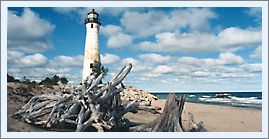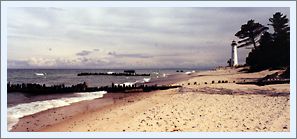|
Historical
information

The Lake Superior coastline between Whitefish Point and Grand Island
stands as one of the most beautiful stretches of shoreline in all of the
Midwest. With pleasure boaters, tour boats and kayakers making their
leisurely way along the coast to soak up the natural beauty. It is
difficult to imagine that during the 1800's this stretch of seemingly
bucolic coastline was known to mariners as "The Shipwreck
Coast," with the hulks of innumerable vessels pushed onto the shore
by violent storms out of the north, or lost in the pea soup fogs which
frequently enveloped the area.
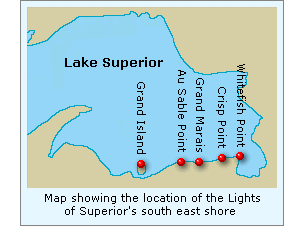 Since the early 1850's, the Lighthouse
Board had been working on establishing a series of Lights to guide
mariners along this treacherous stretch, with Lights established at
Whitefish Point in 1848, Grand Island in 1867, Big Sable Point in 1874
and Grand Marais in 1895. As further witness to the dangers represented
by this stretch of coastline, Congress approved the establishment of
four life saving stations between Vermilion and Deer Park on June 20,
1874, one of which was designated as Station Ten, and built at an
unnamed point approximately fifteen miles west of Whitefish Point.
Although David Grummond was appointed as the first keeper at life saving
station 10, it would be Christopher Crisp who served as keeper from 1878
until 1890 who would have the most lasting impact on the area, as Crisp
became so well known that the point on which the station was established
would become forever known as "Crisp's Point." Since the early 1850's, the Lighthouse
Board had been working on establishing a series of Lights to guide
mariners along this treacherous stretch, with Lights established at
Whitefish Point in 1848, Grand Island in 1867, Big Sable Point in 1874
and Grand Marais in 1895. As further witness to the dangers represented
by this stretch of coastline, Congress approved the establishment of
four life saving stations between Vermilion and Deer Park on June 20,
1874, one of which was designated as Station Ten, and built at an
unnamed point approximately fifteen miles west of Whitefish Point.
Although David Grummond was appointed as the first keeper at life saving
station 10, it would be Christopher Crisp who served as keeper from 1878
until 1890 who would have the most lasting impact on the area, as Crisp
became so well known that the point on which the station was established
would become forever known as "Crisp's Point."
After several wrecks occurred off the
point, the Lighthouse Board observed that "this is a dangerous
point for vessels bound down the lake in thick weather. These vessels
all try to make Whitefish Point, but a slight variation in their course
from the nearest point of departure will run them ashore near Crisps
Point." Estimating that an appropriate lighthouse and fog signal
could be built for $18,000, the Board made its initial request for an
appropriation for establishing a new light station at Crisp's Point in
its 1896 annual report. Congress evidently disagreed with the need for
the new station, as it failed to appropriate the requested funds.
However, convinced of the need for the station, the Board reiterated its
plea in each of its annual reports for the following six years until
Congress finally came through with the requested appropriation on June
28, 1902.
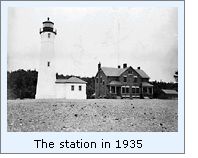 Under the direction of Eleventh
District Engineer Major Lansing H. Beach, a fifteen-acre site for the
new Light was selected in August 1902, plans for the structures and iron
work were drawn up, and contracts awarded for furnishing the building
materials and iron work for the tower and fog signal plants. Title for
the reservation was obtained on May 21, 1903, and work began soon
thereafter with the erection of a timber wharf to facilitate the
delivery of materials. By September, the exterior brick work of the
tower, dwelling and 22' x 42' fog signal building were complete, and a
wood frame boat house and ways had been erected. After a brief
interruption to recover from a violent storm which obliterated the wharf
and boat ways on September 23, work continued with the installation of
the first fog signal plant, the erection of a barn for the keeper's
horses, completion of the dwelling interior. Under the direction of Eleventh
District Engineer Major Lansing H. Beach, a fifteen-acre site for the
new Light was selected in August 1902, plans for the structures and iron
work were drawn up, and contracts awarded for furnishing the building
materials and iron work for the tower and fog signal plants. Title for
the reservation was obtained on May 21, 1903, and work began soon
thereafter with the erection of a timber wharf to facilitate the
delivery of materials. By September, the exterior brick work of the
tower, dwelling and 22' x 42' fog signal building were complete, and a
wood frame boat house and ways had been erected. After a brief
interruption to recover from a violent storm which obliterated the wharf
and boat ways on September 23, work continued with the installation of
the first fog signal plant, the erection of a barn for the keeper's
horses, completion of the dwelling interior.
 The District Lampist arrived at the
station and carefully hoisted the lens components into the lantern for
assembly atop the cast iron pedestal which had been installed to receive
it. Designed and built by Sautter & Lemonnier of Paris, the fixed
red Fourth Order lens was located at a focal plane of 62 feet, affording
the Light with a distance of visibility of 15 miles at sea. While work
was virtually complete, winter's icy grasp forced abandonment of the
site on December 18, and the station stood empty to await completion on
the opening of the 1904 navigation season. The District Lampist arrived at the
station and carefully hoisted the lens components into the lantern for
assembly atop the cast iron pedestal which had been installed to receive
it. Designed and built by Sautter & Lemonnier of Paris, the fixed
red Fourth Order lens was located at a focal plane of 62 feet, affording
the Light with a distance of visibility of 15 miles at sea. While work
was virtually complete, winter's icy grasp forced abandonment of the
site on December 18, and the station stood empty to await completion on
the opening of the 1904 navigation season.
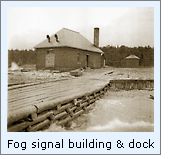 Keeper John E Smith, First Assistant
William J Gramer and Second Assistant Charles H Basel were appointed to
man the new station, with Smith and Gramer arriving at the station on
March 3, and moving their belongings into the new dwelling. Basel
reported for duty on April 27, and the three men set about cleaning up
and readying the station for the return of the working party. Smith and
his crew exhibited the station's Fourth Order lens for the first time on
May 5, and the lighthouse tender AMARANTH returned with the work party
and the steam plant and whistle later that month. Over the following
month, installation of the boiler and a 10-inch locomotive whistle was
completed and the system tested to ensure that it provided the station's
predetermined characteristic repeated 60-second cycle consisting of a
ten second blast followed by 50 seconds of silence. Finishing touches
were put on the buildings, and with construction complete on June 10,
1904, the AMARANTH returned to transport the working party to their next
assignment. Keeper John E Smith, First Assistant
William J Gramer and Second Assistant Charles H Basel were appointed to
man the new station, with Smith and Gramer arriving at the station on
March 3, and moving their belongings into the new dwelling. Basel
reported for duty on April 27, and the three men set about cleaning up
and readying the station for the return of the working party. Smith and
his crew exhibited the station's Fourth Order lens for the first time on
May 5, and the lighthouse tender AMARANTH returned with the work party
and the steam plant and whistle later that month. Over the following
month, installation of the boiler and a 10-inch locomotive whistle was
completed and the system tested to ensure that it provided the station's
predetermined characteristic repeated 60-second cycle consisting of a
ten second blast followed by 50 seconds of silence. Finishing touches
were put on the buildings, and with construction complete on June 10,
1904, the AMARANTH returned to transport the working party to their next
assignment.
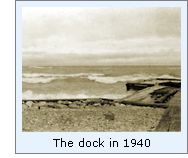 A work crew returned in 1905 and
installed a second boiler with an improved 10-inch chime whistle in the
fog signal building. The locomotive whistle on the original boiler was
removed and also upgraded with a similar chime whistle. The crew also
erected a brick service room at the entrance to the tower to provide the
keepers with a working area for lamp cleaning and lens maintenance. 1906
saw the installation of 750 feet of concrete walks connecting the
station buildings and a new 132 foot long stone-filled timber landing
crib was erected in 1907. 1907 was also likely a memorable year for
Crisp Point's keepers, as they labored to shovel 24 tons of coal into
the hungry boilers to keep the whistles screaming a station-record 383
hours. 1907 was also the year in which government reports on the station
began using the name Crisp Point, as opposed the Crisp's Point, as had
been the case previously. A work crew returned in 1905 and
installed a second boiler with an improved 10-inch chime whistle in the
fog signal building. The locomotive whistle on the original boiler was
removed and also upgraded with a similar chime whistle. The crew also
erected a brick service room at the entrance to the tower to provide the
keepers with a working area for lamp cleaning and lens maintenance. 1906
saw the installation of 750 feet of concrete walks connecting the
station buildings and a new 132 foot long stone-filled timber landing
crib was erected in 1907. 1907 was also likely a memorable year for
Crisp Point's keepers, as they labored to shovel 24 tons of coal into
the hungry boilers to keep the whistles screaming a station-record 383
hours. 1907 was also the year in which government reports on the station
began using the name Crisp Point, as opposed the Crisp's Point, as had
been the case previously.
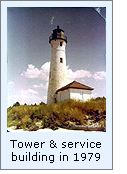 The characteristic of the light changed
was changed from fixed red to fixed white on April 12, 1924, and the
illuminating apparatus changed to an incandescent oil vapor system with
a resulting increase in output from 780 candlepower to 2,900
candlepower. Wave action across the beach in front of the station was a
constant problem, and a number of timber piers were erected along the
shore in an attempt to minimize the problem. The chime whistles were
removed from the fog signal in 1933, and replaced with an electric
powered air siren, which received compressed air provided by a diesel
engine-powered compressor. The characteristic of the light changed
was changed from fixed red to fixed white on April 12, 1924, and the
illuminating apparatus changed to an incandescent oil vapor system with
a resulting increase in output from 780 candlepower to 2,900
candlepower. Wave action across the beach in front of the station was a
constant problem, and a number of timber piers were erected along the
shore in an attempt to minimize the problem. The chime whistles were
removed from the fog signal in 1933, and replaced with an electric
powered air siren, which received compressed air provided by a diesel
engine-powered compressor.
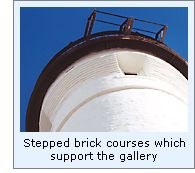 With the Coast Guard's assumption for
responsibility for the nation's aids to navigation in 1939, a program of
cost reduction and automation was instituted. To this end, a generator
and battery equipment was ordered in 1940 to allow the electrification
of the Crisp Point and the elimination of the need for full-time
resident keepers at the station. This electrification and automation was
completed in 1941, and the station boarded-up and left to the elements
with the exception of infrequent inspection by crews from Coast Guard
station Whitefish Point. With the Coast Guard's assumption for
responsibility for the nation's aids to navigation in 1939, a program of
cost reduction and automation was instituted. To this end, a generator
and battery equipment was ordered in 1940 to allow the electrification
of the Crisp Point and the elimination of the need for full-time
resident keepers at the station. This electrification and automation was
completed in 1941, and the station boarded-up and left to the elements
with the exception of infrequent inspection by crews from Coast Guard
station Whitefish Point.
 With improvements in radio technology
and radar, the decision was made to deactivate the station in 1947.
Unmanned and exposed to the elements and vandalism, the structures began
to deteriorate rapidly. Considering them an "attractive
nuisance," the Coast Guard demolished all of the station structures
with the exception of the tower and attached service room in 1965. With improvements in radio technology
and radar, the decision was made to deactivate the station in 1947.
Unmanned and exposed to the elements and vandalism, the structures began
to deteriorate rapidly. Considering them an "attractive
nuisance," the Coast Guard demolished all of the station structures
with the exception of the tower and attached service room in 1965.
The station was officially
decommissioned in 1994, and without keepers maintaining the protective
piers, shoreline erosion had progressed to the point that the lake was
lapping at the very base of the tower itself. After the brick service
room collapsed in November 1996, the GSA feared that the tower itself
was in danger of toppling, and not wishing the responsibility and cost
of stabilizing or demolishing the tower, the property was scheduled for
auction in 1997.
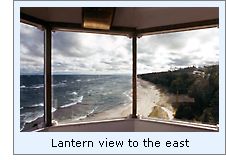 Ohio visitors Don and Nellie Ross came
across the old station, and taken with the natural beauty and history of
the location, partnered with a number of area residents to form the
Crisp Point Lighthouse Preservation Society, with their charter being
the restoration and long term survival of what was left of the station.
Stone reinforcement was trucked-in to the site in 1998 and laid around
the tower foundation, and numerous trees have been planted to stem
erosion of the dunes. The tower was cleaned and painted in 1999, and
wooden walkways have been built, also to stem erosion atop the dune on
which the tower sits. Ohio visitors Don and Nellie Ross came
across the old station, and taken with the natural beauty and history of
the location, partnered with a number of area residents to form the
Crisp Point Lighthouse Preservation Society, with their charter being
the restoration and long term survival of what was left of the station.
Stone reinforcement was trucked-in to the site in 1998 and laid around
the tower foundation, and numerous trees have been planted to stem
erosion of the dunes. The tower was cleaned and painted in 1999, and
wooden walkways have been built, also to stem erosion atop the dune on
which the tower sits.
A visit to Crisp Point is a
"must" for any lighthouse fans, as it remains one of the most
desolate and beautiful locations in all of the Great
Lakes.

Keepers of
this Light

Click here
to see a complete listing of all Crisp Point Light keepers compiled by
Phyllis L. Tag of Great Lakes Lighthouse Research.

Seeing this Light

Crisp Point will forever be remembered as a gem at the end of one of the most grueling drives we have ever undertaken.
The first fifteen miles of the drive are on numbered County roads which are little more than groomed sand trails. The last five miles are on what appears to be nothing more than a logging trail.
As you progress, the trail gets progressively narrower and increasingly twisty, as the trail has to circumvent every tree that has grown in the path. We felt really fortunate that we never encountered a vehicle coming in the opposite direction, because we never remembered any place where there was sufficient room to pass! The road ended at the beach,
with a half mile walk put us at the light.
This one of the most magnificently desolate locations we have visited, and other than Sue’s frequently glancing the edge of the woods for any sign of bears, remains in our
minds as one of our top ten favorite lights.
We
returned to "The Point" on a windy and cool September 15,
2000, and met with Don Ross of the C.P.L.P.S. We had arranged to meet
with Don some time before, and he opened the tower and we climbed to the
lantern room. The view of the lake was fantastic, and watching the waves
rolling into the shore was almost mesmerizing. While it was chilly outside,
the solar gain in the tower warmed things up nicely, as we stood around
and spent a pleasant half hour chatting with Don about the work that has
been done at The Point since our last visit.

Finding this
Light

We can provide no better directions on how to get to Crisp Point than
those provided by the Crisp Point Lighthouse Society on their website.
Click on the link to their site above, and then select the "Driving
Directions" link. They have both a map and descriptive text with
odometer readings. We wholeheartedly recommend that you print their
directions and take them along with you. You will not regret it!

Contact
information

Click here to visit The Crisp Point Light Historical Society website.

 Reference
Sources Reference
Sources
Annual reports of the Lighthouse
Board, various, 1886 1909
Annual reports of the Lighthouse Service, various, 1910-1938
Annual reports of the Lake Carrier's Association, various,
1906-1930
Personal
visits to Crisp Point in 1998, 2002 & 2009
Photographs from author's personal collection.
Keeper listings for this light appear courtesy of Great Lakes Lighthouse Research |
